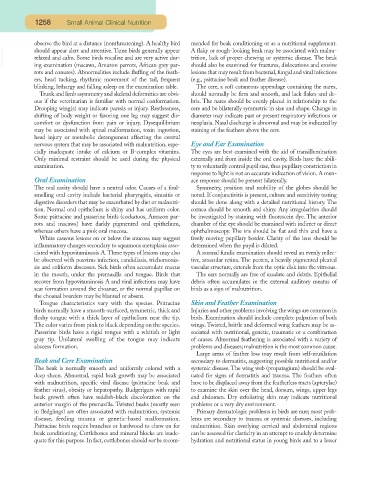Page 1208 - Small Animal Clinical Nutrition 5th Edition
P. 1208
1258 Small Animal Clinical Nutrition
observe the bird at a distance (nonthreatening). A healthy bird mended for beak conditioning or as a nutritional supplement.
VetBooks.ir should appear alert and attentive. Tame birds generally appear A flaky or rough-looking beak may be associated with malnu-
trition, lack of proper chewing or systemic disease. The beak
relaxed and calm. Some birds vocalize and are very active dur-
ing examination (macaws, Amazon parrots, African grey par-
should also be examined for fractures, dislocations and erosive
rots and conures). Abnormalities include fluffing of the feath- lesions that may result from bacterial,fungal and viral infections
ers, head tucking, rhythmic movement of the tail, frequent (e.g., psittacine beak and feather disease).
blinking, lethargy and falling asleep on the examination table. The cere, a soft cutaneous appendage containing the nares,
Trunk and limb asymmetry and skeletal deformities are obvi- should normally be firm and smooth, and lack flakes and de-
ous if the veterinarian is familiar with normal conformation. bris. The nares should be evenly placed in relationship to the
Drooping wing(s) may indicate paresis or injury. Restlessness, cere and be bilaterally symmetric in size and shape. Change in
shifting of body weight or favoring one leg may suggest dis- diameter may indicate past or present respiratory infections or
comfort or dysfunction from pain or injury. Dysequilibrium neoplasia. Nasal discharge is abnormal and may be indicated by
may be associated with spinal malformation, toxin ingestion, staining of the feathers above the cere.
head injury or metabolic derangement affecting the central
nervous system that may be associated with malnutrition, espe- Eye and Ear Examination
cially inadequate intake of calcium or B-complex vitamins. The eyes are best examined with the aid of transillumination
Only minimal restraint should be used during the physical externally and from inside the oral cavity. Birds have the abili-
examination. ty to voluntarily control pupil size, thus pupillary constriction in
response to light is not an accurate indication of vision. A men-
Oral Examination ace response should be present bilaterally.
The oral cavity should have a neutral odor. Causes of a foul- Symmetry, position and mobility of the globes should be
smelling oral cavity include bacterial pharyngitis, sinusitis or noted. If conjunctivitis is present, culture and sensitivity testing
digestive disorders that may be exacerbated by diet or malnutri- should be done along with a detailed nutritional history. The
tion. Normal oral epithelium is shiny and has uniform color. cornea should be smooth and shiny. Any irregularities should
Some psittacine and passerine birds (cockatoos, Amazon par- be investigated by staining with fluorescein dye. The anterior
rots and macaws) have darkly pigmented oral epithelium, chamber of the eye should be examined with indirect or direct
whereas others have a pink oral mucosa. ophthalmoscopy. The iris should be flat and thin and have a
White caseous lesions on or below the mucosa may suggest freely moving pupillary border. Clarity of the lens should be
inflammatory changes secondary to squamous metaplasia asso- determined when the pupil is dilated.
ciated with hypovitaminosis A. These types of lesions may also A normal fundic examination should reveal an evenly reflec-
be observed with poxvirus infection, candidiasis, trichomonia- tive, avascular retina. The pecten, a heavily pigmented pleated
sis and coliform abscesses. Sick birds often accumulate mucus vascular structure, extends from the optic disk into the vitreous.
in the mouth, under the premaxilla and tongue. Birds that The ears normally are free of exudate and debris. Epithelial
recover from hypovitaminosis A and viral infections may have debris often accumulates in the external auditory meatus of
scar formation around the choanae, or the normal papillae on birds as a sign of malnutrition.
the choanal boarders may be blunted or absent.
Tongue characteristics vary with the species. Psittacine Skin and Feather Examination
birds normally have a smooth-surfaced, symmetric, thick and Injuries and other problems involving the wings are common in
fleshy tongue with a thick layer of epithelium near the tip. birds. Examination should include complete palpation of both
The color varies from pink to black depending on the species. wings. Twisted, brittle and deformed wing feathers may be as-
Passerine birds have a rigid tongue with a whitish or light sociated with nutritional, genetic, traumatic or a combination
gray tip. Unilateral swelling of the tongue may indicate of causes. Abnormal feathering is associated with a variety of
abscess formation. problems and diseases; malnutrition is the most common cause.
Large areas of feather loss may result from self-mutilation
Beak and Cere Examination secondary to dermatitis, suggesting possible nutritional and/or
The beak is normally smooth and uniformly colored with a systemic disease. The wing web (propatagium) should be eval-
deep sheen. Abnormal, rapid beak growth may be associated uated for signs of dermatitis and trauma. The feathers often
with malnutrition, specific viral disease (psittacine beak and have to be displaced away from the featherless tracts (apterylae)
feather virus), obesity or hepatopathy. Budgerigars with rapid to examine the skin over the head, dorsum, wings, upper legs
beak growth often have reddish-black discoloration on the and abdomen. Dry exfoliating skin may indicate nutritional
anterior margin of the premaxilla. Twisted beaks (mostly seen problems or a very dry environment.
in fledglings) are often associated with malnutrition, systemic Primary dermatologic problems in birds are rare; most prob-
disease, feeding trauma or genetic-based malformation. lems are secondary to trauma or systemic diseases, including
Psittacine birds require branches or hardwood to chew on for malnutrition. Skin overlying cervical and abdominal regions
beak conditioning. Cuttlebones and mineral blocks are inade- can be assessed for elasticity in an attempt to crudely determine
quate for this purpose. In fact, cuttlebones should not be recom- hydration and nutritional status in young birds and to a lesser

